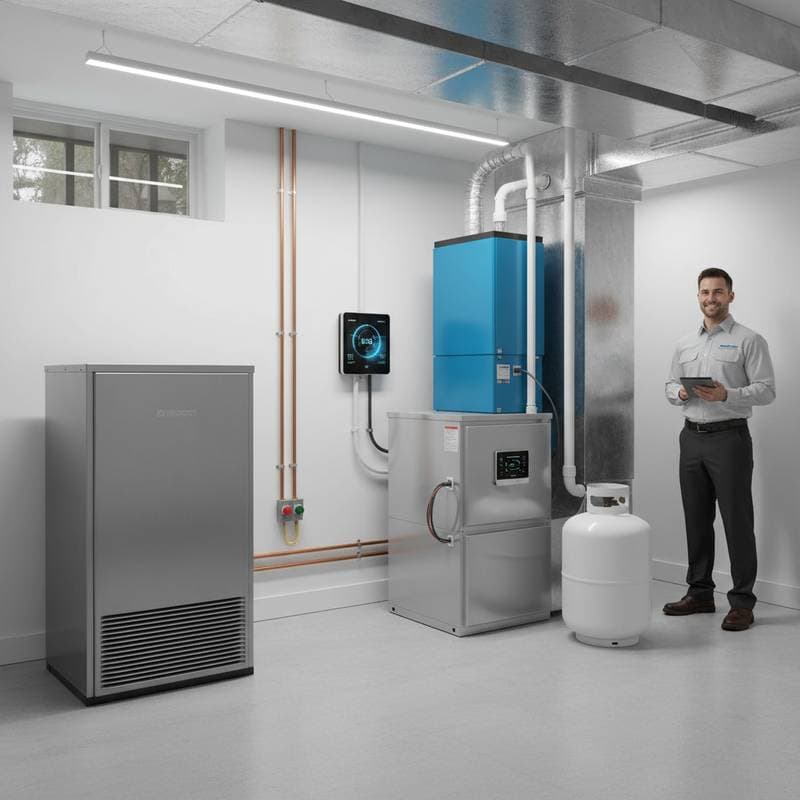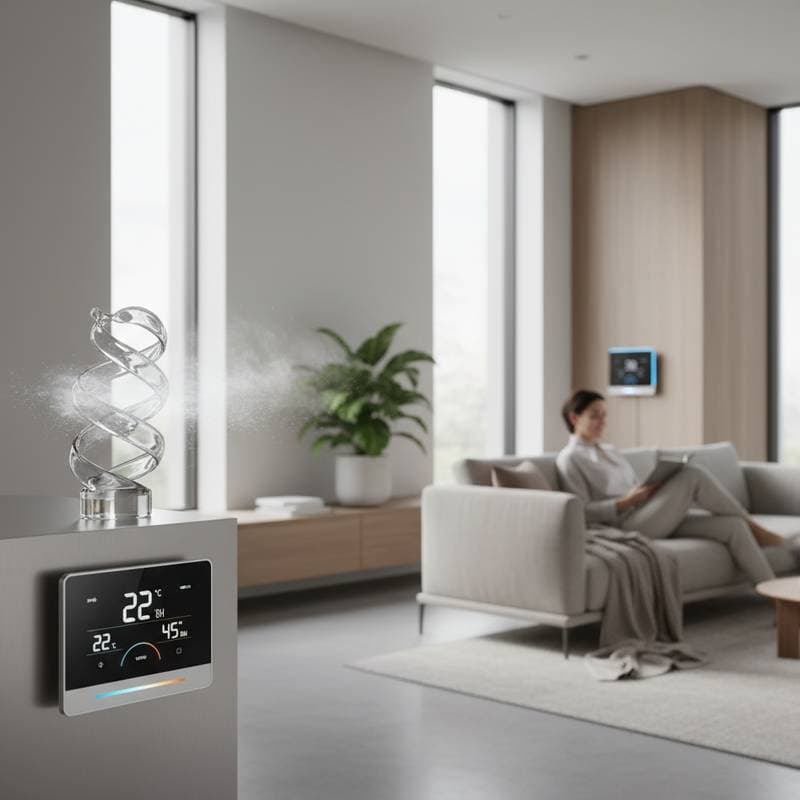How Dual-Fuel HVAC Systems Revolutionize Home Heating in 2025
Dual-fuel HVAC systems integrate an electric heat pump with a gas or propane furnace to provide reliable heating. These systems switch automatically based on outdoor temperatures, using the heat pump for mild conditions and the furnace for extreme cold. Homeowners benefit from consistent comfort and reduced energy expenses through this intelligent operation.
Key cost elements include equipment selection, system capacity, and installation requirements. Complete installations average $10,500, with a range of $8,000 to $14,000. Annual maintenance runs $200 to $600, while upgrades or conversions cost $1,500 to $3,500.
| Service Type | Average Cost |
|---|---|
| Complete dual-fuel HVAC installation | $8,000 to $14,000 |
| Heat pump replacement only | $4,000 to $8,000 |
| Furnace replacement only | $3,000 to $6,000 |
| Conversion of existing system | $5,000 to $9,000 |
| Annual maintenance and tune-up | $200 to $600 |
| Metric | Amount |
|---|---|
| National average cost | $10,500 |
| Minimum cost | $6,000 |
| Maximum cost | $15,000 |
| Average cost range | $8,000 to $14,000 |
Cost data derives from industry research and reported project expenses.
Understanding Dual-Fuel HVAC Systems
A dual-fuel HVAC system, known also as a hybrid heating system, combines two primary heat sources. It employs an electric heat pump during moderate weather and shifts to a gas or propane furnace in colder conditions. This setup maintains steady indoor temperatures while optimizing energy consumption.
The heat pump functions by extracting heat from outdoor air and transferring it indoors, a process far more efficient than generating heat directly. Once temperatures fall below the heat pump's effective range, typically around 30 degrees Fahrenheit, the furnace activates. A programmable thermostat oversees the transition, operating without manual adjustments.
Detailed Cost Breakdowns
Pricing for dual-fuel HVAC systems fluctuates based on home dimensions, brand choices, and site-specific challenges. The following breakdowns highlight common scenarios.
By Home Size
| Home Size (sq. ft.) | Average Installed Cost |
|---|---|
| Up to 1,500 | $7,000 to $9,000 |
| 1,500 to 2,500 | $9,000 to $12,000 |
| 2,500 to 3,500 | $12,000 to $15,000 |
| Over 3,500 | $15,000 to $18,000 |
Homes with greater square footage demand larger units, which elevate both material and labor expenses.
Labor Versus Materials
| Category | Average Cost |
|---|---|
| Equipment (heat pump and furnace) | $6,000 to $10,000 |
| Labor and installation | $2,000 to $4,000 |
| Ductwork upgrades or modifications | $1,000 to $3,000 |
Equipment represents the largest portion of expenses, though intricate setups or duct revisions can substantially increase the overall amount.
By System Efficiency
| Efficiency Level | SEER / AFUE Rating | Average Cost |
|---|---|---|
| Standard | 14 SEER / 80 AFUE | $8,000 to $10,000 |
| High-efficiency | 16 SEER / 90 AFUE | $10,000 to $13,000 |
| Premium | 18 SEER / 95 AFUE | $12,000 to $15,000 |
Systems with superior efficiency ratings involve higher initial investments but yield lower long-term utility costs.
Key Cost Factors
Multiple variables determine the final price of a dual-fuel HVAC system. Awareness of these allows for precise budgeting and strategic choices.
- System size: Units designed for larger areas necessitate greater capacity and extended installation efforts.
- Efficiency rating: Higher Seasonal Energy Efficiency Ratio (SEER) for heat pumps and Annual Fuel Utilization Efficiency (AFUE) for furnaces increase upfront costs while decreasing operational expenses over time.
- Brand quality: Established brands provide extended warranties, reduced noise levels, and sophisticated controls, contributing to elevated prices.
- Installation complexity: Properties lacking gas infrastructure or featuring obsolete ducts often require supplementary modifications.
- Fuel source: Propane configurations exceed natural gas options in cost due to tank setup and delivery logistics.
- Climate zone: Regions with harsh winters depend more heavily on furnace operation, potentially raising fuel expenditures relative to temperate areas.
- Controls and thermostats: Integration of smart devices and zoning enhances usability but adds to the total outlay.
- Permits and inspections: Compliance with local regulations typically incurs fees for professional reviews and approvals, amounting to several hundred dollars.
Related Costs to Consider
Installation extends beyond core components, incorporating various ancillary expenses.
| Related Expense | Typical Cost |
|---|---|
| Old system removal and disposal | $300 to $800 |
| Electrical upgrades or rewiring | $500 to $1,500 |
| Gas line or propane tank installation | $400 to $2,000 |
| Smart thermostat integration | $200 to $600 |
| System inspection or testing | $100 to $300 |
These elements promote safe and effective system performance post-installation.
Maintenance and Care Tips
Regular maintenance sustains optimal function and extends the durability of dual-fuel systems. Consistent care also minimizes energy demands.
- Replace or clean air filters every one to three months to ensure proper airflow.
- Arrange annual professional tune-ups to inspect all components.
- Clear debris from outdoor heat pump coils to maintain heat transfer efficiency.
- Examine condensate drains for obstructions to prevent water damage.
- Evaluate ductwork for leaks or insulation deficiencies.
- Verify thermostat calibration and control functionality.
- Inspect gas lines for signs of leakage or deterioration.
- Ensure sufficient space around external units for ventilation.
Diligent upkeep prolongs the service life of heat pump and furnace elements alike.
Repair or Replace Decisions
For existing HVAC setups, whether to repair or replace hinges on performance indicators and financial considerations.
- Age of system: Units exceeding 15 years often warrant replacement for enhanced efficiency and dependability.
- Repair frequency: Recurring issues indicate progressive deterioration that incurs ongoing expenses.
- Energy efficiency: Upgrading to a dual-fuel model can reduce utility bills by 20 to 30 percent compared to older equipment.
- Comfort consistency: Inconsistent temperatures or poor air circulation point to diminishing effectiveness.
- Rebates and incentives: Regional programs frequently subsidize efficient installations, offsetting replacement costs.
Replacement proves more economical when repair expenses surpass half the cost of a new system.
Ways to Save Money
Strategic approaches enable homeowners to lower dual-fuel HVAC expenditures without sacrificing quality.
- Obtain quotes from at least three certified HVAC professionals to compare options.
- Inquire about applicable energy rebates and federal tax credits.
- Schedule installation during slower seasons, such as fall or spring, for discounted rates.
- Select appropriately sized systems to avoid unnecessary capacity and expenses.
- Perform routine maintenance to avert expensive breakdowns.
- Combine projects, such as adding duct sealing or attic insulation, for bundled savings.
- Incorporate programmable or smart thermostats to optimize daily energy patterns.
- Evaluate current fuel pricing to decide between propane and natural gas.
These methods align comfort needs with budget constraints effectively.
Frequently Asked Questions
How much does a dual-fuel HVAC system cost?
Installed costs for a full dual-fuel system generally fall between $8,000 and $14,000. Variations stem from home size, efficiency specifications, and selected brands.
Are dual-fuel systems more efficient than standard HVAC units?
Yes, these systems enhance efficiency by leveraging electric heat pumps for moderate conditions and gas furnaces for severe cold, resulting in tailored energy utilization.
How long does a dual-fuel HVAC system last?
With appropriate maintenance, systems endure 15 to 20 years. Heat pumps may need replacement sooner than furnaces due to continuous seasonal operation.
Can I convert my existing HVAC system to dual-fuel?
Conversion is feasible for many properties with existing ducts and partial components, such as a furnace or heat pump. Expect costs of $5,000 to $9,000.
What type of fuel can dual systems use?
Furnace components operate on natural gas or propane, while heat pumps rely on electricity, offering flexibility across available energy types.
Do dual-fuel systems work in very cold climates?
These systems perform well in frigid areas. The furnace engages automatically when heat pump efficiency wanes in low temperatures.
What maintenance does a dual-fuel system need?
Essential tasks include annual professional servicing, frequent filter replacements, and coil cleaning to support both furnace and heat pump operations.
Are rebates available for dual-fuel systems?
Many utility providers and government programs offer rebates for high-efficiency dual-fuel installations. Eligibility depends on location and system specifications; consult local incentives for details.
Plan Your Dual-Fuel Upgrade Today
Transitioning to a dual-fuel HVAC system positions homeowners for long-term savings and superior comfort. Evaluate your current setup, explore financing options, and connect with qualified installers to initiate the process. This investment not only addresses immediate heating needs but also supports sustainable energy practices for years ahead.



